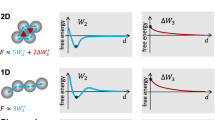Abstract
In this paper, a method was proposed that can simulate the systems containing both rigid and soft parts with rigid body constraints. The idea was to consider the characteristics of rigid parts in their center of mass with three rotational degrees of freedom. In order to compute the systems containing both flexible and rigid parts, standard techniques in molecular dynamics were utilized for flexible parts. However, special procedures were proposed and formulated for rigid parts. Some details on the implementation of the proposed algorithm on GPU were also presented. Next, two case studies were solved. In the first example, a ball mill with the rigid particle of different shapes was considered and the performance of the proposed algorithm was checked and compared with the results obtained from others. In the second example, different self-assembly phases of a mixed rigid and non-rigid polymer molecule with Lennard–Jones pairwise interaction were studied. It was shown that the obtained self-assembly phases were identical to those reported by other researchers.














Similar content being viewed by others
References
Alder BJ, Wainwright TE (1959) Studies in molecular dynamics. I. General method. J Chem Phys 31:459
Rahman A (1964) Correlations in the motion of atoms in liquid argon. Phys Rev 136:A405–A411
Nguyen H (2008) GPU Gems 3. Addison-Wesley, Boston (Chapter 31)
Ryckaert J, Ciccotti G, Berendsen H (1977) Numerical integration of the cartesian equations of motion of a system with constraints: molecular dynamics of n-alkanes. J Comput Phys 23:327
Dubbeldam D, Oxford GAE, Krishna R, Broadbelt LJ, Snurr RQ (2010) Distance and angular holonomic constraints in molecular simulations. J Chem Phys 133:034114
Eastman P, Pande VS (2010) Constant constraint matrix approximation: a robust, parallelizable constraint method for molecular simulations. J Chem Theory Comput 6:434
Zhang Zh, Glotzer ShC (2004) Self-assembly of patchy particles. Nanoletters 4:1407–1413
Zohdi TI (2011) Dynamics of clusters of charged particulates in electromagnetic fields. Int J Numer Methods Eng 85:1140–1159
Zohdi TI (2012) Dynamics of charged particulate systems. Modeling, theory and computation. Springer, New York
Plimpton S (1995) Fast parallel algorithms for short-range molecular dynamics. J Comput Phys 117:1
Heine DR, Petersen MK, Grest GS (2010) Effect of particle shape and charge on bulk rheology of nanoparticle suspensions. J Chem Phys 132:184509
Mountain R (2007) Solvation structure of ions in water. Int J Thermophys 28:536–543
Johnson SD, Mountain RD, Meijer PHE (1995) Simulation of C60 through the plastic transition temperatures. J Chem Phys 103:1106
CUDA toolkit 4.2 programming manual
Meel JA, Arnold A, Frenkel D, Zwart SFP, Belleman RG (2008) Harvesting graphics power for MD simulations. Mol Simul 34:259–266
Miller TF III, Eleftheriou M, Pattnaik P, Ndirango A, Newns D, Martyna GJ (2002) Symplectic quaternion scheme for biophysical molecular dynamics. J Chem Phys 116(20):8649
LAMMPS source code, http://lammps.sandia.gov/ (2010)
Andersen HC (1980) Molecular dynamics simulations at constant pressure and/or temperature. J Chem Phys 72:2384–2393
Tuckerman ME, Alejandre J, Lopez-Rendon R, Jochim AL, Martyna GJ (2006) A Liouville-operator derived measure-preserving integrator for molecular dynamics simulations in the isothermal-isobaric ensemble. J Phys A 39:5629–5651
Bitzek E, Koskinen P, Gahler F, Moseler M, Gumbsch P (2006) Structural relaxation made simple. PRL 97:170201
Zhang HP, Makse HA (2005) Jamming transition in emulsions and granular materials. Phys Rev E 72:011301
Yoneya M, Berendsen HJC, Hirasawa K (1994) A noniterative matrix method for constraint molecular-dynamics simulations. Mol Simul 13:395–405
Forester TR, Smith W (1998) SHAKE, rattle, and roll: efficient constraint algorithms for linked rigid bodies. J Comput Chem 19:102–111
McBride C, Wilson MR, Howard JAK (1998) Molecular dynamics simulations of liquid crystal phases using atomistic potentials. Mol Phys 93:955–964
Andersen HC (1983) RATTLE: a ”Velocity” version of the SHAKE algorithm for molecular dynamics calculations. J Comput Phys 52:24–34
Sang-Ho L, Palmo K, Krimm S (2005) WIGGLE: a new constrained molecular dynamics algorithm in Cartesian coordinates. J Comput Phys 210:171–182
Lambrakos SG, Boris JP, Oran ES, Chandrasekhar I, Nagumo M (1989) A modified SHAKE algorithm for maintaining rigid bonds in molecular dynamics simulations of large molecules. J Comput Phys 85:473–486
Leimkuhler B, Skeel R (1994) Symplectic numerical integrators in constrained Hamiltonian systems. J Comput Phys 112:117–125
Gonnet P (2007) P-SHAKE: a quadratically convergent SHAKE in \({\cal O} (n^2)\). J Comput Phys 220:740–750
CUDA toolkit 4.2 reference manual
Stone AJ, Dullweber A, Hodges MP, Popelier PLA, Wales DJ (1995–1996) ORIENT 3.2: A program for studying interactions between molecules. University of Cambridge, Cambridge
Höhner D, Wirtz S, Kruggel-Emden H, Scherer V (2011) Comparison of the multi-sphere and polyhedral approach to simulate non-spherical particles within the discrete element method: Influence on temporal force evolution for multiple contacts. Powder Technol 208:643–656
Mishra BK, Murty CVR (2001) On the determination of contact parameters for realistic DEM simulations of ball mills. Powder Technol 115:290–297
Crane AJ, Francisco J, Veracoechea M, Escobedob FA, Muller EA (2008) Molecular dynamics simulation of the mesophase behaviour of a model bolaamphiphilic liquid crystal with a lateral flexible chain. Soft Mater 4:1820–1829
Tschierske C (2007) Liquid crystal engineering—new complex mesophase structures and their relations to polymer morphologies, nanoscale patterning and crystal engineering. Chem Soc Rev 36:1930–1970
Author information
Authors and Affiliations
Corresponding author
Rights and permissions
About this article
Cite this article
Nouri, N., Ziaei-Rad, S. A technique for calculating particle systems containing rigid and soft parts. Comput Mech 56, 277–290 (2015). https://doi.org/10.1007/s00466-015-1171-0
Received:
Accepted:
Published:
Issue Date:
DOI: https://doi.org/10.1007/s00466-015-1171-0




